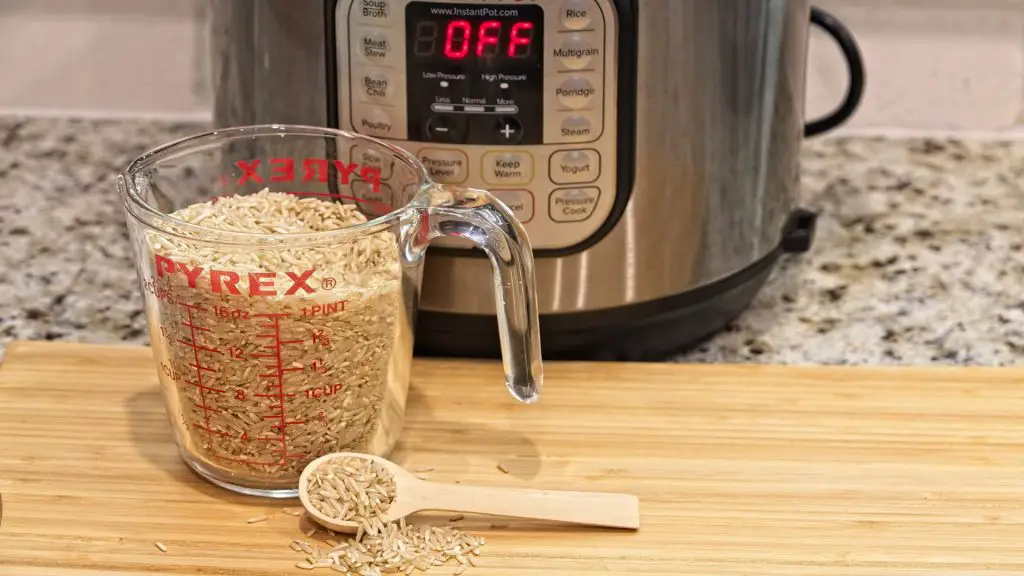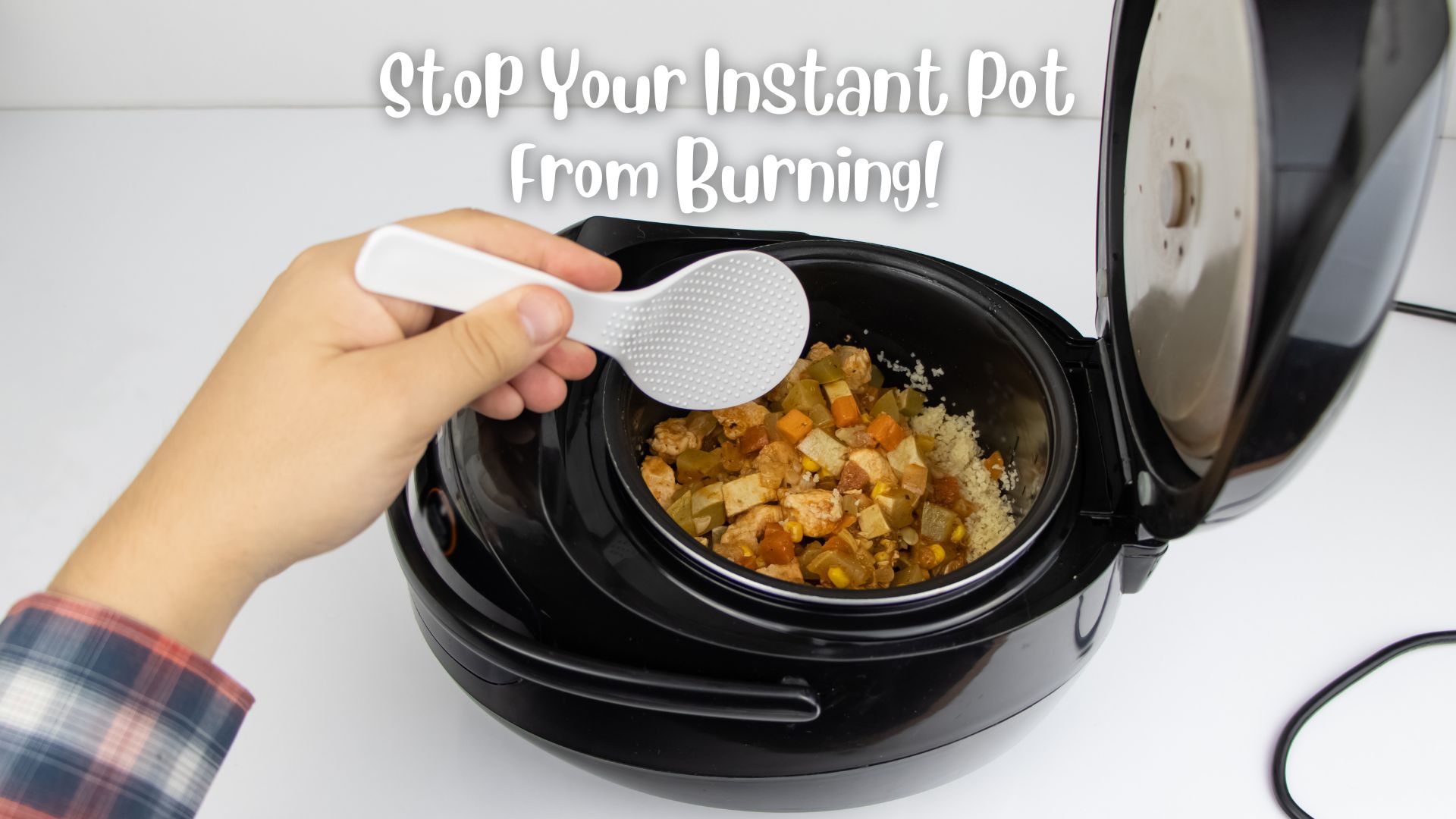Instant pot and pressure cookers have become popular choices in the kitchen because they are faster than stovetop ovens and have various cooking functions. But there is one con: its bottom could burn, causing the food to get charred.
There could be many reasons behind this like you are not following the recipes/manual correctly, you set the pressure cooking time wrong, or due to a mechanical flaw in the pressure cooker. I will list various reasons that could cause food to burn and some tips on how to stop the pressure cooker from burning on the bottom.

Reasons For A Instant Pot To Burn From The Bottom
If your Instant Pot or regular pressure cooker is burning on the bottom, don’t panic! Here are some common reasons and what to do about them.
1. Not Enough Liquid In The Pressure Cooker
A pressure cooker uses steam rising from the water to build pressure, which heats the food. If there is not enough liquid, then the pressure will not be created, and the food will most likely burn, creating a burnt bottom.
2. Tomato Products At The Bottom
Many of the recipes you try using pressure cookers will include tomato products in the form of tomato sauce, paste, diced tomatoes, etc. When the sugars in the tomato products come into contact with heat, they start to caramelize, prompting the burn notice.
Also, tomato water’s viscosity is thicker than that of water, so it doesn’t evaporate quickly and stays stagnant at the bottom. And when it is exposed to heat for too long, it can scorch the bottom of the pot.
Top Tip: Always add the tomato products on top after you have added the meat or veggies. And do not stir them. This way, they will not come in contact with the bottom of the pot.
3. Sauteing Veggies Or Meat
Spices in a pressure cooker burn quickly. So, when you are done sautéing something with spices, press the cancel button, add water, and give it a good stir.
When you are sauteing ground meat, don’t dump the whole block of meat into the pressure cooker. If you do that, the meat will start to burn from the bottom up. Instead, you must break it into little pieces and keep stirring them well.
Pro Tip: If meat bits or burnt food are stuck to the bottom, be sure to deglaze them with hot water. Stir the water and clean out all the food debris. Leave it in the instant pot before you resume cooking because it will add more flavor to your food.
4. Forgetting To Set The Pressure Valve To Seal From Venting
The pressure valve at the top of the pressure cooker must be set at “sealing.” This valve makes sure that the pressure is sealed inside.
If you accidentally start the pressure cooking process with the valve on “venting,” the leaking steam will decrease water levels inside the pressure cooker and burn food.
5. A Faulty Sealing Ring
A silicone sealing ring is located inside the instant pot’s lid. This silicone ring is what seals the steam inside the pressure cooker. If it is damaged or dislocated, the steam will keep shooting until the water runs out.
How To Prevent A Pressure Cooker From Burning?

Now that you know the reasons responsible for a burnt pressure cooker, here are some tips to help you avoid them:
1. Pour Sufficient Water Into The Pressure Cooker
The water is used to increase steam build-up and keep the temperature below burning limits. It is due to insufficient cooking liquid that food burns and sticks to the bottom of the pressure cooker.
So, always make sure to add an adequate amount of liquid, either water or stock, so that it does not run out during the cooking cycle. Add extra water if you are pressure-cooking rice or dried beans because they will absorb the liquid before they are done cooking.
2. Pressure Cook On Low Heat
You should adjust the heat with a manual pressure cooker when it starts making hissing noises. The pressure gauge starts to hiss if the pressure is too high. And with each hiss, it lets out steam, and less cooking liquid is left inside.
So, you should pressure cook on low heat to prevent pressure cooker burn notice due to the loss of liquids.
Do not think that keeping the heat at its highest setting will decrease cooking time. Once there is enough pressure inside, turn the heat on low for a while to avoid burning food due to high pressure.
3. Put Down A Rack Or A Metal Plate
If food sits at the bottom for too long, it will overheat and scorch the instant pot. So, when you are cooking chicken, meat, or heating something, you should put down a rack or a metal plate first to elevate the food. Pour a cup of water before placing the rack, and then start pressure cooking.
You could also place bowls or food wrapped in foil on the rack. This is called the pot-in-pot method.
4. Make Sure That The Sealing Mechanism Works
When you have added everything to the pressure cooker and closed the lead, you should ensure that the pressure release valve is set to “sealing.” This valve does not let the steam escape. Check to see that the floating valve is sealed before each cooking cycle.
5. Dairy Products And Gravy Should Be Added Last
Dairy products such as milk, cheese, and cream are too thick to boil. The same goes for gravy, sauces, and flour. If the recipe requires one of these products, then don’t add them at the beginning because they will overheat and burn.
Instead, add them at the end of the cycle, after the meal is done cooking, and stir them well. If you have to add thick sauce, be sure to thin it out with stock or water.
You should be mindful of ingredients with high starch content and keep track of their recommended cooking times.
6. Do Not Overfill The Instant Pot
You will see the instruction to only fill two-thirds of the instant pot in the manual. Avoid filling the pressure cooker because there should be some room at the top for enough steam to collect and build pressure inside.
Conclusion

If you are a beginner at using pressure cookers and instant pots, you are bound to make some errors. Sometimes, when you are in a hurry, you might make a mistake and stray off the instruction manual. Or you tweak the recipe to make up for the lost time.
But now you know what could be causing the bottom of the pressure cooker to burn and how you can prevent that from happening.
There could be other things causing the burn. Sometimes, it might just be because the instant pot is not working properly. You will start to get the hang of it as you use it more and see the burn message less and less. After all, only practice can lead to perfection!
